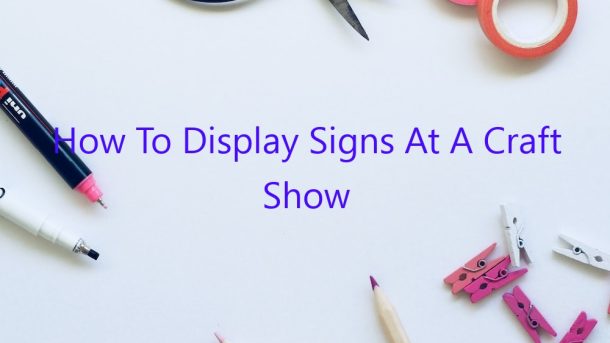When you’re setting up for a craft show, one of the most important aspects to consider is how you will display your signs. Signs are a great way to let potential customers know what your booth is all about, what kind of products you’re selling, and how to find you. Here are a few tips on how to display your signs at a craft show:
1. Make sure your signs are easy to see.
Your signs should be large and brightly colored so that they stand out against the background. They should also be placed in a spot where they can be easily seen by passersby.
2. Use a variety of different types of signs.
Don’t just use one type of sign – mix it up to create more of a visual impact. Try using a variety of sizes, shapes, and colors.
3. Keep your signs neat and organized.
Make sure your signs are arranged in an attractive and orderly manner. This will help to make your booth look more professional and welcoming.
4. Use graphics and illustrations.
Graphics and illustrations can be a great way to add interest to your signs and to help explain your products.
5. Use clear and concise text.
Your text should be easy to read and understand. Make sure to use simple, easy-to-remember slogans and phrases.
6. Keep your signs updated.
As your products and booth layout change, make sure to update your signs accordingly. This will help to ensure that your booth is always accurately represented.
By following these tips, you can create an eye-catching and informative display for your craft show signs.
Contents
How do you set up a display on Craft Show?
Craft shows are a great opportunity to sell your crafts to the public. However, in order to make the most of this opportunity, you need to have a good display. Here is how to set one up:
First, decide what you will be selling. You will need to have a variety of items on display, as different people will be interested in different things. Make sure that you have a good selection of items, and that everything is well-organized.
Next, you need to decide on your display. There are a variety of options available, from traditional tables and racks to more creative displays. Choose what will work best for your items and your space.
Once you have your display set up, make sure everything is neat and tidy. You want your booth to look attractive and inviting to potential customers.
Finally, make sure to practice your sales pitch. You want to be able to explain what your items are and why someone should buy them. Be friendly and enthusiastic, and you will be sure to make the most of your craft show experience!
How do you display prints at a craft fair?
If you’re looking to sell prints at a craft fair, there are a few things you need to keep in mind. In this article, we’ll discuss how to display your prints in a way that will draw in customers and help you make sales.
First, you’ll need to decide on what type of display to use. There are a few different options to choose from, and each has its own advantages and disadvantages. The most common type of display is a table display. This is a simple setup where you place your prints on a table and they are visible to customers from all angles. However, this type of display can be difficult to navigate, and it can be difficult to see the prints from a distance.
A better option is a hanging display. This type of display hangs your prints on a wall, which makes them visible from all angles. It also takes up less space than a table display. However, it can be more expensive to set up, and it’s not as versatile as a table display.
Finally, you can also use a floor display. This type of display is similar to a table display, but it is placed on the floor instead of on a table. This type of display is good for larger prints, and it makes it easy for customers to browse through your prints. However, it can be difficult to set up and it takes up a lot of space.
Once you’ve decided on a display, you’ll need to decide what to put on it. When displaying prints, it’s important to create a cohesive look. This means that you should use the same type of frame for all of your prints, and you should use the same type of display for all of your prints. This will help create a cohesive look and make your booth look professional.
In addition to using the same type of frame and display, you should also use the same type of signage. This means that you should use the same type of font, color, and size for all of your signage. This will help create a unified look for your booth.
Finally, you’ll need to decide what to put on your signage. Your signage should list the prices of your prints, and it should also include your contact information. You can also use your signage to promote your work. For example, you can use your signage to list the different types of prints that you sell.
When setting up your booth, it’s important to keep the customer in mind. Think about what you would want to see if you were browsing through a booth of prints. Make sure that your prints are easy to see, and make sure that your signage is easy to read. In addition, make sure that your booth is neat and organized. This will help create a professional look for your booth and it will make it easier for customers to find what they are looking for.
How do you stand out at a craft fair?
Craft fairs are a great opportunity to sell your crafts to the public, but it can be difficult to stand out from the competition. Here are a few tips to help you stand out from the crowd:
1. Make sure your crafts are unique and well-made.
2. Display your crafts in an interesting way.
3. Offer samples of your crafts to potential buyers.
4. Have a catchy slogan or tagline.
5. Price your crafts fairly.
6. Have a good attitude and be friendly to potential buyers.
7. Take the time to talk to potential buyers and answer their questions.
8. Promote your crafts on social media.
9. Have a good selection of crafts to choose from.
10. Stay organized and keep your booth tidy.
How do I set up a vendor table?
Setting up a vendor table is a great way to get your business in front of potential customers. It can also be a great way to make money by selling your products or services. Here are some tips on how to set up a vendor table:
1. Decide what type of vendor table you want. There are a few different types of vendor tables, including:
– Standard vendor table: This is the most common type of vendor table. It is a rectangular table that is typically 6-8 feet long.
– Square vendor table: This type of table is square, and is typically 4-6 feet wide.
– Banquet table: This type of table is typically 10-12 feet long, and is narrower than a standard vendor table.
– Island vendor table: This type of table is a square or rectangular table that is raised off the ground, and is typically used for food vendors.
2. Decide how much space you need. When setting up your vendor table, you will need to account for the space that the table takes up, as well as the space for your products or displays. Make sure to leave enough space for people to walk around your table.
3. Reserve a vendor table. Most conventions, trade shows, and fairs will have a designated area for vendor tables. You can reserve a vendor table by contacting the event organizer.
4. Set up your table. When setting up your table, make sure to place your products or displays in the middle of the table, and leave enough space on either side for people to walk around.
5. Dress your table. Make sure your table is dressed neatly with a tablecloth and/or runners. You can also use props to dress up your table, such as flowers, plants, or banners.
6. Promote your table. Make sure to promote your table by putting up signage or flyers around the event. You can also hand out flyers or business cards to people walking by.
7. Have a sales pitch ready. When talking to potential customers, be prepared to give them a brief sales pitch about your business. You can also offer them a discount if they purchase your products or services on the spot.
8. Be friendly and outgoing. When talking to potential customers, be friendly and outgoing. Try to make a connection with them and build a rapport. This will help you close more sales.
9. Take advantage of networking opportunities. When attending an event, take advantage of the networking opportunities that are available. Talk to other vendors and event attendees, and see if you can set up a meeting or get their contact information.
10. Have fun! Attending events as a vendor can be a lot of fun. Make sure to enjoy yourself and take advantage of the opportunity to promote your business.
How much product should I bring to a craft fair?
When you’re preparing to sell your crafts at a craft fair, it’s important to bring enough product to make a good impression, but not so much that you end up with a lot of leftover inventory. Here are some tips for figuring out how much product to bring.
First, assess the size of the craft fair. If it’s a small, local event, you’ll likely need less product than if you’re selling at a large, national fair.
Also, consider the type of crafts you’re selling. If they’re small and easy to transport, you can bring more of them. If they’re large and bulky, you’ll need to bring less.
Finally, think about what you’ll be selling them for. If you’re selling at a fair with high prices, you’ll need less product than if the prices are lower.
In general, it’s a good idea to bring at least 100 items to a craft fair. If you’re selling at a smaller event, you can bring less, but if you’re selling at a large event, you’ll need more.
What do I need to sell at a craft fair?
If you’re thinking of selling your crafts at a local craft fair, there are a few essentials you’ll need to have in order to make the most of the opportunity. Here’s a list of the most important things to bring with you:
1. Your crafts! This one is obvious, but be sure to bring a good selection of your best work.
2. A table and/or tent. If you’re not provided with one, you’ll need to bring your own.
3. A display for your crafts. This can be anything from a simple tablecloth to a professionally-made display stand.
4. Business cards. You’ll want to have these to give to potential customers.
5. Money. You’ll need to bring enough money to cover your costs for the day, including table rental, materials, and so on.
6. A sign. This can be as simple as a piece of paper with your name and contact information on it, or something more elaborate.
7. A friend! It can be helpful to have someone to help you set up and/or take down your booth, and to help out with sales throughout the day.
How do I display prints without frames?
There are a few different ways that you can display prints without frames. One option is to use a mat or a mount. A mount is a piece of paper or cardboard that is larger than the print, and the print is placed in the middle of the mount. The mount is then placed in a frame. Another option is to use a shadow box. A shadow box is a box that is made out of wood or plastic, and the print is placed in the back of the shadow box. The shadow box is then placed on a shelf or hung on the wall.




